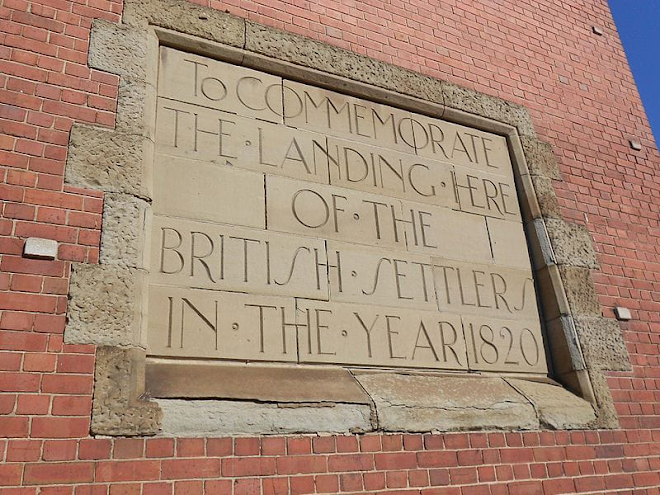From: "Becky Horne" < beckyjh@telkomsa.net>
Subject: Cemeteries in Port Elizabeth - Part II
Date: Tue, 17 Aug 2004 23:38:37 +0200
Subject: Cemeteries in Port Elizabeth - Part II
Date: Tue, 17 Aug 2004 23:38:37 +0200
Continued from Part I
SOURCE: Genealogical Society of SA - East Cape Branch Newsletter
November 1987 No. 4. Contribution from Liz ESHMADE
In St. Georges Park is yet another small cemetery where lie many of Scots descent and members of the Presbyterian and Congregational Churches. Here we find three sons, and their wives, of Thomas STERLEY who is buried in Russell Road. We find
4-year-old Vera WOODFORD, who died in 1884, buried with her faithful nurse, Elizabeth TAGG (d. 1885). Then there is Murdoch MACKENZIE, of Scotland, who drowned in the Bay in 1859 aged 43 years "in performance of his duty on the beach". His stone was erected by a "few Highland friends". Just inside the gate lie John and Mary MATTHEWS, who died at 74 years in 1867 and 83 in 1888 respectively. They must have seen many changes in the 19th centaury world. There are the children of James and Agnes CAMPBELL, four of whom did not live past three years of age and the fifth, James, died in 1892, in far away Rio de Janeiro, Brazil, aged only 22 years. Was it the old scourges like smallpox or measles, which took them so young? So many names, like the CAMPBELL's still exist today, but are there any VAN MENGERSHAUFER's left or was young Otto, who only lived one day in 1875 the last of the line?
As the town grew, so did the need for larger burial grounds and this takes us to the tree filled South End Cemetery. Here the area, in the early days, was divided into blocks for each religion. Here are soldiers from the Boer War resting beneath their "For King and Country" iron crosses, rusting in the sea air. There is a large memorial listing the sailors drowned during the Great Storm of 1902 in which so many ships were wrecked. The religious communities, both Catholic and Anglican, settled here to teach and nurse. There are the nursing sisters of The Little Company of Mary, Sisters of Nazareth, Sisters of the Assumption. Bishops of St. Augustines Cathedral lay beneath magnificent carved slabs of Italian marble, their epitaphs long and in Latin. Here too are the war graves and memorials in private plots to those like 19-year old Arnold TAYLOR who died in France in 1917 during the Great War and 25 year old Graham STANTON, of the 3rd Transvaal Scottish who died in North Afri!
ca in 1941 during WWII. The Windhoek air disaster of 1962 is also recalled. Many are the graves of young and old taken during the terrible 'flu epidemic of 1917-1918 and there are many small graves of children and babies who died from diseases which we scarcely know today. On the South Eastern side is the "free ground' where lay the members of the Muslim community. Their tombstones are, for the most, inscribed in Arabic.
Unlike these three tree-filled cemeteries, North End is a vast open tract of land across which the wind howls on its way to the sea. In the old section are many unmarked and unedged graves. We shall never know who is buried here because the burial records were lost many years ago, in a fire. The oldest grave, as far as we know, is that of William RUNDLE who died in May 1868. Another is 1851, but as the man died in Uitenhage it is unlikely that he is buried here as the cemetery had not yet opened. Mrs. Susan DE POORTERE née STOWMAN lived to be 114 years old. Mrs. Elizabeth Dawson GEER, 104 yrs was born in 1821 the daughter of Settler FROST, and must thus be one of the earliest "Bayonians" A Lonely rusty iron cross bears only the date 8.5.1901. Who was the man who gave his life in the Boer War? We shall never know.
Here, as in South End the flu epidemic is recalled, but here too, in the mid 1940's we find victims of the polio of which was going to get so much worse. There are many stones to the memory of "Mother" or "Boetje". Knowing who owns the plot does not mean that these people had the same surname. On the right is the only Jewish cemetery in Port Elizabeth and at the back the now disused Hindu Crematorium. Alister MULLER, the aviation pioneer, rests here with his wife. In an open area stands a modern memorial recalling names of young and old who died in the local Concentration Camp during the Boer war. This cemetery has people of every race and creed. A large block belongs to the Chinese community, many of their inscriptions written in Chinese. St. Marks Church has a vast block, which is still in use and the Moravian Mission block contains row upon row of tiny graves. These were children of the Coloured community who died of malnutrition of the late '30's and '40's.
It was these good missionaries who stemmed the tide of this morality. The free ground at North End is very large, well mowed, lawn interspersed here and there with tombstones, some inscribed, some not. So you see, every story ever told, every heroic deed ever done, every battle fought, every tear ever shed, is to found in a cemetery. After all, we mortals ARE the stories, humble or proud. The details may be sketchy or explicit, in prose or in verse. Read and "listen" - you'll learn far more than you thought.
Conclusion.
Best wishes
Becky
